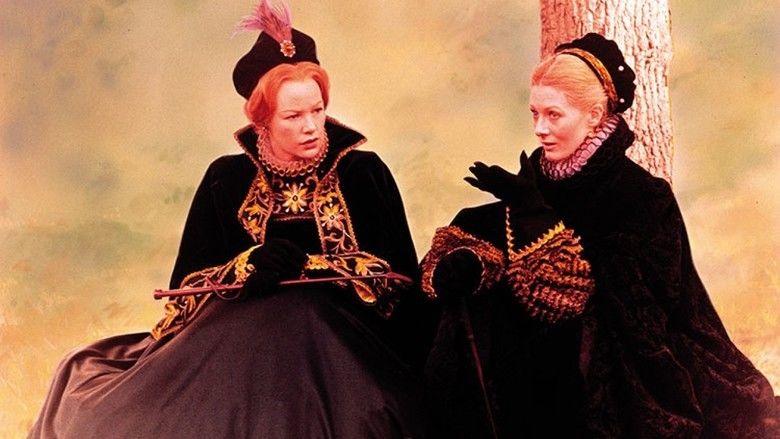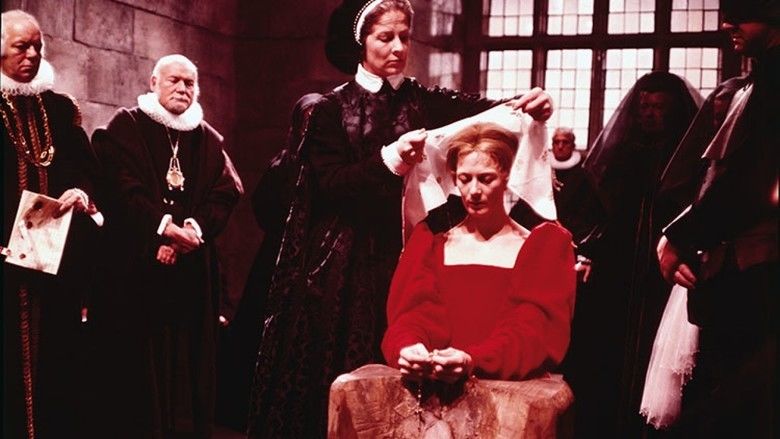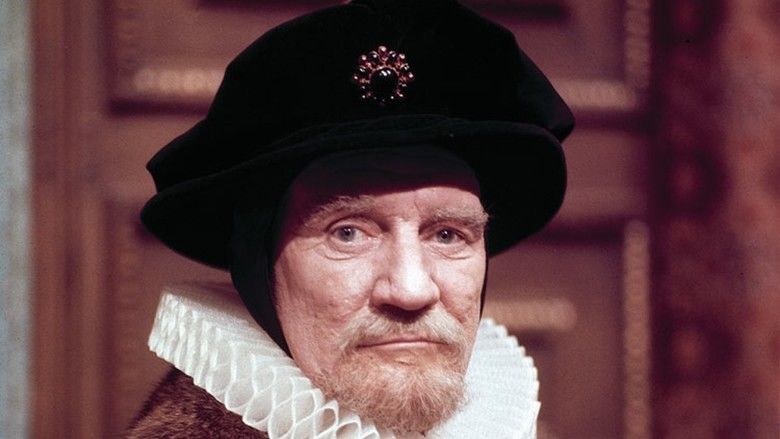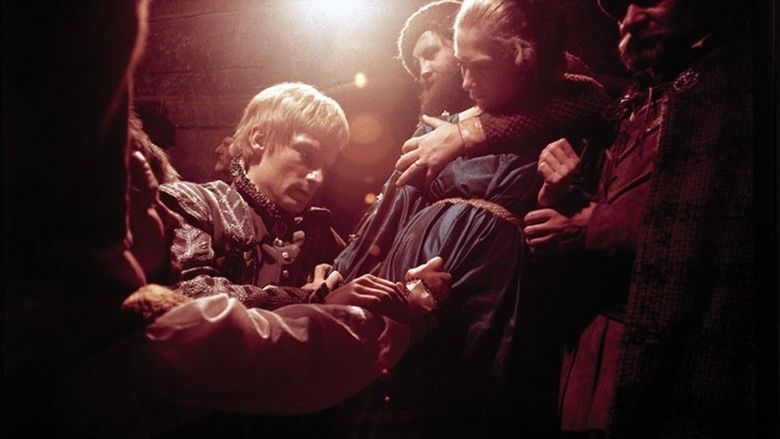Mary, Queen of Scots (1971 film)
7.6 /10 1 Votes7.6
Music director J.J. Barry Duration Language English | 7.4/10 IMDb Genre Biography, Drama, History Screenplay John Hale Country United Kingdom | |||||||||||||||||||||||||||||||||
 | ||||||||||||||||||||||||||||||||||
Release date December 1971 Writer John Hale (original screenplay) Cast (Mary, Queen of Scots), (Queen Elizabeth), (James Stuart), (Henry - Lord Darnley), (Lord Bothwell), (William Cecil) Similar movies Star Wars: Episode I - The Phantom Menace , Frozen , Macbeth , Alice in Wonderland , Looper , Under the Skin Tagline MARY, QUEEN OF SCOTS, who ruled with the heart of a woman. | ||||||||||||||||||||||||||||||||||
Mary queen of scots trailer
Mary, Queen of Scots is a 1971 British Universal Pictures biographical film based on the life of Mary, Queen of Scots, written by John Hale and directed by Charles Jarrott. Leading an all-star cast are Vanessa Redgrave as the title character and Glenda Jackson as Elizabeth I. Jackson had previously played the part of Elizabeth in the BBC TV drama Elizabeth R, screened in February and March 1971, the first episode of which was also written by Hale.
Contents
- Mary queen of scots trailer
- Elizabeth r 1971 execution of mary queen of scots
- Plot
- Historical liberties
- Reception
- Awards and nominations
- References

The screenplay was written by John Hale and the film directed by Charles Jarrott. Like the play by Friedrich Schiller and the opera by Gaetano Donizetti, it takes considerable liberties with history in order to achieve increased dramatic effect, in particular two fictitious face-to-face encounters between the two Queens (who never met in real life). The film received a less than enthusiastic review from the New York Times, but was nominated for several awards.

Elizabeth r 1971 execution of mary queen of scots
Plot

Following the death of her husband Francis II of France in 1560, Mary, Queen of Scots (Vanessa Redgrave) returns to her native land. Though fearless, unselfish, and very beautiful, the young queen faces many challenges. As in neighbouring England, the Protestant faith has been embraced by many nobles of Scotland; in addition, the Catholic Mary has to deal with her half-brother James Stewart, Lord Moray's (Patrick McGoohan) ambitions for rule. He suggests that Mary enjoy herself in Scotland, and pass the time with dancing and feasting. Moray wants to rule Scotland while the lovely but inexperienced Mary becomes a figurehead.

Fearing that Mary has ambitions for England's throne, Elizabeth I of England (Glenda Jackson) decides to weaken her claim by sending her favourite, the ambitious Robert Dudley (Daniel Massey), to woo and marry Mary. She promises that Mary will become her heir if she agrees to the marriage. Sly Elizabeth also sends the younger, dashing but weak and spoiled Lord Darnley (Timothy Dalton), from a powerful Catholic family. Tempted by the handsome Darnley, Mary impulsively chooses him for marriage. Lord Moray, a Protestant, opposes the marriage, but Mary ignores him. She even exiles Moray to strengthen her own authority. Elizabeth is satisfied that reckless, passionate Mary's romantic misadventures will keep her busy in Scotland and give shrewd, practical Elizabeth less to worry about.
Soon after the wedding, spoiled brat Darnley throws a childish temper tantrum, complaining that he has no real power and is merely Mary's King Consort. A disillusioned Mary soon banishes Darnley from her bed and frequently consults with the gentle, soft-spoken Italian courtier David Riccio (Ian Holm). Darnley had previously had him as a lover and accuses him of fathering Mary's expected child.
A group of Scottish lords persuade Darnley to help get rid of Riccio, whom they murder in Mary's presence. To escape, she persuades Darnley that the plotters will turn against him, and they flee to the safety of Lord Bothwell (Nigel Davenport). He has been an ally of Mary since her arrival in Scotland. After he defeats the plotters, Mary forces a truce among their leader Moray, Darnley and Bothwell. Mary gives birth to a son, James, who is expected to succeed both Mary and the unmarried, childless Elizabeth.
The peace is short-lived. The weak, selfish Darnley still wants power, though by now he is hideously scarred and already dying of syphilis (the pox). Mary pities him, but finds herself falling in love with the rough but loyal Bothwell. With Moray's help, they arrange for Darnley to be killed in a gunpowder explosion at his manor; Darnley escapes before the blast but is stabbed to death. Bothwell marries Mary, and their few brief nights together are blissful. But Moray rejoins the Scottish lords and leads a rebellion against them. He forces Mary to abdicate, and she and her husband are driven into exile, Mary to England and Bothwell to Denmark. Mary's young son James is to be crowned King of Scotland (although Moray will effectively rule for years) and brought up as a Protestant.
In England, Mary begs Elizabeth for money and an army to regain her throne. Instead Elizabeth takes her prisoner, keeping her locked away in luxurious captivity in a remote castle. Elizabeth's closest advisor, Sir William Cecil (Trevor Howard), is anxious to get rid of Mary, but Elizabeth fears to set a precedent by putting an anointed monarch to death. She also fears that Mary's death might spark a rebellion by her Catholic subjects and cause problems with powerful France and Spain. As a result, Mary is doomed to an open-ended captivity. Over time the once proud Queen of Scots succumbs to an empty routine, plotting half-heartedly to escape but growing increasingly comfortable in her luxurious seclusion. She occupies herself with a lazy daily schedule of cards, embroidery and gossip, talking vaguely of escape yet sleeping later and later each morning. Yet while the helpless imprisoned queen has lost all will to harm her enemies, they continue to plot her final destruction.
With the help of his associate Walsingham (Richard Warner), Cecil finds evidence of Mary's involvement in the conspiracy to assassinate Elizabeth known as the Babington Plot. Finally Elizabeth confronts Mary, who regains her royal pride and behaves defiantly at their secret meeting. Although Elizabeth offers her mercy if she begs for forgiveness, Mary will not beg for mercy in public. She endures the trial, conviction and execution. She knows her son James will ultimately succeed to the English throne.
Historical liberties
For dramatic effect, the film presents two meetings between the queens, although they never met in life. Moreover, the film depicts Mary as enjoying a late-morning cup of hot chocolate in bed (and even requesting it when she is a prisoner) when this was not a popular drink in the British Isles until well into the 18th century.
Reception
Vincent Canby had little good to say about the film in the New York Times of 4 February 1972, describing it as "a loveless, passionless costume drama". He wrote, "Unfortunately there is no excitement whatsoever in what Charles Jarrott, the director, and John Hale, the author of the original screenplay, have put together...Mary, Queen of Scots intends, I assume, to illuminate history...yet all it's really doing is touching bases, like a dull, dutiful student...Because both Miss Redgrave and Miss Jackson possess identifiable intelligence, [the film] is not as difficult to sit through as some bad movies I can think of. It's just solemn, well-groomed and dumb."
Roger Ebert gave the film three stars and lauded the interpretation of Redgrave and Jackson, noting however the "soap opera" approach to the script.
Awards and nominations
Mary, Queen of Scots was nominated for Academy Awards for Best Actress in a Leading Role (Vanessa Redgrave), Best Art Direction-Set Decoration (Terence Marsh, Robert Cartwright, Peter Howitt), Best Costume Design, Best Music, Original Dramatic Score and Best Sound (Bob Jones, John Aldred).
The film received several Golden Globe nominations, including Best Motion Picture - Drama, Best Motion Picture Actress - Drama (Glenda Jackson), Best Motion Picture Actress - Drama (Vanessa Redgrave), Best Original Score (John Barry), and Best Screenplay (John Hale).
References
Mary, Queen of Scots (1971 film) WikipediaMary, Queen of Scots (1971 film) IMDb Mary, Queen of Scots (1971 film) themoviedb.org
